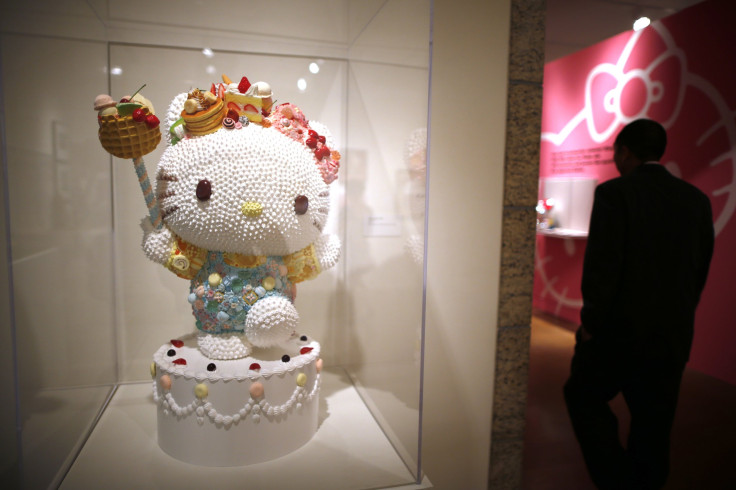5 Secrets Of Hello Kitty's Enduring Brand (No, It Doesn't Include The Hello Kitty Vibrator)

Ken Belson was at a party Wednesday night in downtown L.A.'s Little Tokyo for Kitty Con, the first-ever Hello Kitty convention in the U.S. The author of "Hello Kitty: The Remarkable Story of Sanrio and the Billion Dollar Feline Phenomenon," with Brian Bremner, described what he saw. "There was a 'vintage village' at Kitty Con, with the oldest Hello Kitty product on display as if it were Queen Elizabeth’s jubilee diamond," he said. "It was a Hello Kitty coin purse, in its own case, with security around it, and a giant light shining on it." Booths hosted by assorted sponsors and licensees abounded, including Sephora, which carries a Hello Kitty cosmetics line, Hormel, which has Hello Kitty-branded SPAM, and Beats by Dre.
To understand how Hello Kitty has become such an enduring brand and icon as her 40th anniversary on Saturday is celebrated, International Business Times talked to Ken Belson about what Sanrio did right.
Sanrio designed Hello Kitty products for children, teens, and adults
One of the most brilliant moves Sanrio ever made, Belson said, was to understand that the audience Hello Kitty was initially designed for in Japan would grow up.
"Sanrio knew that the children they were selling the coin purses to were going to be 15-year-olds. So they deliberately set out to design her for teens, for professional women, for moms. Children usually grow out of toys and leave them behind. They might revisit those characters on Halloween, but in Japan, there's an acceptance of animated characters. There's no taboo against an adult woman embracing Hello Kitty. No one looks askance if you wear a Hello Kitty purse to work."
Hello Kitty is a fashion statement in the U.S., promoted by pop stars
"There’s been an organic acceptance of Hello Kitty by the pop glitterati," Belson said of Hello Kitty in the U.S.
"In the past 15 years, Hello Kitty has been adopted by pop stars, and she's a fashion statement in the U.S.," he said -- more so than in Japan. Christina Aguilera once blurted out on TV that she loved her. Singer-songwriter Lisa Loeb's album "Hello, Lisa" featured a song, "Underdog," whose video had Hello Kitty all over it. Heatherette designer Richie Rich designed a whole line of clothes based on Hello Kitty, and recently created a dress for Lady Gaga made of stuffed Hello Kitty dolls. Avril Lavigne even had a "Hello Kitty" song that was slammed as racist by critics.
Hello Kitty's blankness is universal
"Hello Kitty is an open vessel for kids’ emotions," said Belson. "She has a Japanese sensibility and colors -- but she doesn’t read as Japanese. She looks like a cat, she has an English name. In post-war 1970s Japan, there was still a large measure of respect for the Western world, respect for America and Britain. Giving an 'international gloss' to the character, giving her a backstory of being born in London, gives her international cachet."
When designing Hello Kitty, the original designer, Yuko Shimizu, was inspired by the Cheshire Cat from "Alice in Wonderland," which is interesting, considering Hello Kitty doesn't have a mouth. "She's the Mona Lisa of animated characters,” Belson said. "Since emotions are displayed in the mouth, she’s not threatening. You can impose emotions on her. Snoopy is snarky, Mickey is happy, Donald is silly. Hello Kitty's blankness appears to have given her a universality. "
Hello Kitty's global reach was part of a deliberate design strategy
Sanrio's internationalization was a deliberate strategy, argues Belson. "They went to other parts of Asia, the U.S. Yes, they exported notebooks and pens, but to be sophisticated, they had to tailor her to each country. The design team had to make her American, adapt to trends."
Yuko Shimizu, who designed the original Hello Kitty, left the company in the 1970s. Another woman, Yuko Yamaguchi, has designed her since 1980. "She evolved the product," Belson said, "and changed its shape and size."
Licensing of Hello Kitty is getting much bigger -- but there are limits
There are around 22,000 Hello Kitty products on the market, according to PopCult Magazine. Sanrio produces and markets more than half of them; the rest are made and licensed by hundreds of other companies. When Belson wrote "Hello Kitty" in 2003, Sanrio made more than $1 billion a year -- half of it from Hello Kitty.
As successful as licensing Hello Kitty is, Sanrio doesn't want the the brand destroyed, so there are limits, says Belson -- Hormel's SPAM notwithstanding -- to what it will license her for. He says Sanrio won't let guns, cigarettes or sharp objects become Hello Kitty products. As for that thing out there that looks like a Hello Kitty vibrator? Belson says Sanrio executives told him years ago that it is a Hello Kitty "personal massager."
© Copyright IBTimes 2024. All rights reserved.






















